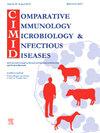The changing reservoir of the zoonotic Hepatitis E virus in Türkiye: A novel potential threat to public health?
IF 2
3区 农林科学
Q4 IMMUNOLOGY
Comparative Immunology Microbiology and Infectious Diseases
Pub Date : 2025-10-07
DOI:10.1016/j.cimid.2025.102407
引用次数: 0
Abstract
Pigs are considered the main reservoir of the zoonotic Hepatitis E virus (HEV) world-wide. However, in countries where there is no pork industry or pork consumption, the adaptation of zoonotic HEV (genotype 3) to different species has remained a controversial issue. The objective of our study was to investigate wild rodents as a potential new reservoir or host animal for the transmission of HEV to humans. In this study, HEV RNA was investigated in liver, lung, and spleen samples from 391 rodents of the genus Microtus collected from areas close to rural settlements and in blood samples taken from 50 anti-HEV IgG/IgM-positive individuals living in these regions. Sequence analyses and molecular characterizations of the HEV strains identified in both species were performed and phylogenetic trees were constructed. HEV RNA was detected in 8 of 50 human blood samples (16 %) and 6 of 391 rodents (1.5 %). When compared with the reference sequences obtained from NCBI, our rodent and human HEV strains were found to be genotype 3. It was determined that the rodent and human HEV sequences obtained from our study were 97.6–98.6 % identical. Reference rodent HEV strains formed a separate phylogenetic branch from the study strains and clustered within the Rocahepevirus group. Our study has shown that wild small mammals may play a role in the epidemiology of zoonotic HEV infection and therefore should be considered as potential reservoirs of the disease. Multidisciplinary collaboration (“One Health” approach) is required for the surveillance and control of HEV infection which threatens the public health.
猪被认为是全世界人畜共患戊型肝炎病毒(HEV)的主要宿主。然而,在没有猪肉工业或猪肉消费的国家,人畜共患戊肝病毒(基因型3)对不同物种的适应仍然是一个有争议的问题。本研究的目的是调查野生啮齿动物作为HEV向人类传播的潜在新宿主或宿主动物。在这项研究中,从靠近农村居民点的地区收集了391只鼠属啮齿动物的肝脏、肺和脾脏样本,并从生活在这些地区的50名抗HEV IgG/ igm阳性个体的血液样本中调查了HEV RNA。对两种HEV菌株进行了序列分析和分子特征分析,并构建了系统发育树。50份人血样中有8份(16% %)和391份啮齿动物血样中有6份(1.5% %)检测到HEV RNA。与NCBI获得的参考序列比较,我们的啮齿动物和人HEV株均为基因型3。结果表明,从我们的研究中获得的啮齿动物和人的HEV序列是97.6-98.6 %相同。参考啮齿动物HEV毒株与研究毒株形成一个单独的系统发育分支,并聚集在罗卡hepevirus组内。我们的研究表明,野生小型哺乳动物可能在人畜共患HEV感染的流行病学中发挥作用,因此应将其视为该疾病的潜在宿主。监测和控制威胁公众健康的HEV感染需要多学科合作(“同一个健康”方法)。
本文章由计算机程序翻译,如有差异,请以英文原文为准。
求助全文
约1分钟内获得全文
求助全文
来源期刊
CiteScore
4.60
自引率
0.00%
发文量
102
审稿时长
40 days
期刊介绍:
Comparative Immunology, Microbiology & Infectious Diseases aims to respond to the concept of "One Medicine" and to provide a venue for scientific exchange. Based on the concept of "Comparative Medicine" interdisciplinary cooperation between specialists in human and animal medicine is of mutual interest and benefit. Therefore, there is need to combine the respective interest of physicians, veterinarians and other health professionals for comparative studies relevant to either human or animal medicine .
The journal is open to subjects of common interest related to the immunology, immunopathology, microbiology, parasitology and epidemiology of human and animal infectious diseases, especially zoonotic infections, and animal models of human infectious diseases. The role of environmental factors in disease emergence is emphasized. CIMID is mainly focusing on applied veterinary and human medicine rather than on fundamental experimental research.

 求助内容:
求助内容: 应助结果提醒方式:
应助结果提醒方式:


